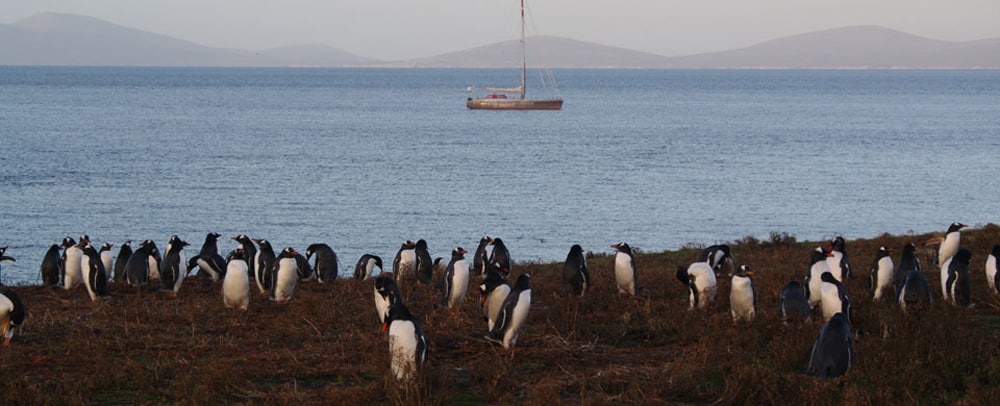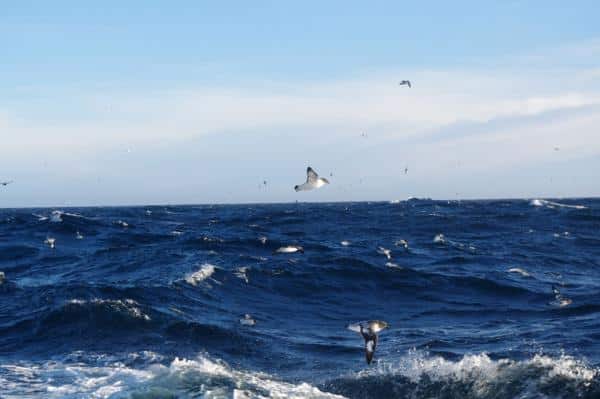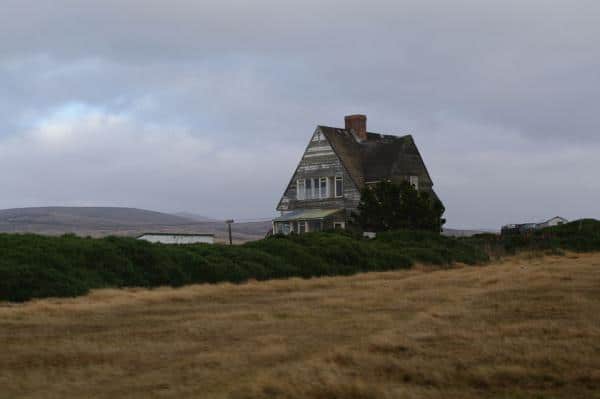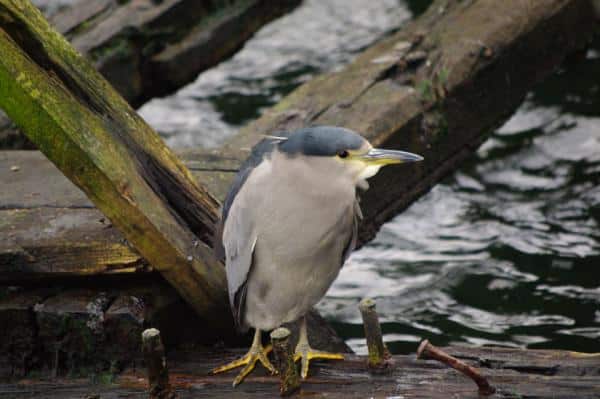
Falkland Islands
I was aboard Pelagic Australis, the 74-foot aluminum expedition sailboat owned by famed ocean racer Skip Novak. We had not yet reached the middle of a four-week delivery trip from Puerto Williams, Chile, to Buenos Aires, Argentina, yet it was hard not to think that we had just passed the (literal!) pinnacle of our voyage. Ahead lay about 500 miles of ocean passage and sea watches of six hours on, six hours off during daylight, followed by four hours on, four hours off, four hours on in a 24-hour period. The plan was three or four days of sailing to the Falkland Islands, passing through the infamous currents of the Strait of Le Maire, which runs between the tip of Tierra del Fuego and Isla de los Estados. Then a few days in Stanley on East Falkland to reprovision and a little leisurely exploration of some of the small islands off the coast of West Stanley before sailing on to Buenos Aires.
We had a stunning sunset in the evening and passed through the strait that night with surprising ease. On the other side though, the beating began. It wasn’t anything compared with what it might have been, but we had about three days of 30- to 35-knot winds on a northeast course and a sea state that slammed us around a bit. Low on solid sleep, it becomes harder to wake up for that 0200 watch, bracing yourself to time your exit from the berth with the next roll of the boat, and trying to wriggle into multiple layers in the dark as the boat pitches and your bunkmate snores. The pilothouse aboard Pelagic Australis is well-designed, with benches to port and starboard and good visibility, so we took turns wedging ourselves into the seats or snuggled in under the cockpit’s hardtop watching the stars and the glowing wake while we waited for a sail change. One night we scurried to the foredeck to add a third reef to the mainsail in 30 knots, with every wave sending a spray of frigid water over us. I was aware, even then, that though it was cold and wet and dark and should be miserable, it was exciting. Its exclusiveness, the rarity of the experience, countered the discomfort and was a mighty aid in denial. The upshot was, I loved it — though, if I am honest, probably not as much as I now remember loving it.
View the complete photo gallery here.

Nonetheless, we were all happy to tie up in Port Stanley. First stop was the Seamen’s Mission for laundry and e-mail home. The following day, a few of us took a tour around East Stanley by Land Rover.
The Falkland Islands is a self-governing U.K. territory, though the legitimacy of that claim has been disputed by Argentina since 1833. Beautiful in a desolate way, the Falklands are home to a mere 3,000 people, including a large population of British soldiers. Most people live in Stanley, but there are dozens of other tiny settlements scattered throughout East and West Falkland and its 677 smaller islands.
This part of the world is best known for its moment on the world stage in 1982 when the Falkland Islands War was fought. Nine hundred and seven people were killed over the 74-day struggle — 649 Argentinian soldiers, 255 British soldiers and three civilians. Tensions between the two countries have never really eased and now hover above the discovery of vast reserves of offshore oil like a dangling match. But the question of whom the Falklands belong to is not so easy to determine. It’s been said that the Falklands are more British than England, and it certainly feels that way. Land Rovers are the most popular method of transportation; fields are full of sheep; Port Stanley is dotted with pubs, red telephone boxes, churches and a neatness that’s particularly English. And the people who live here want to remain citizens of the crown.
The landscape is gorgeous: rolling green fields, peppered with large patches of rocks and boulders, trail down to meet vast sweeps of southern ocean. The Falklands are one of those places with a special light. While I was there, the air seemed constantly charged with a golden glow — the kind of air that suggests a rainbow might appear at any moment. This wild, isolated beauty adds to the sense of a place that’s haunted. The mangled skeleton of a downed Chinook helicopter still lies in a windswept field. At the British and Argentinian graveyards, birds wheel overhead in a gray sky, the ocean laps at the nearby shore, and rows of well-tended but lonely gravestones commemorate the men who came to the Falklands but never left.

Our driver took us through Goose Green, a tiny settlement on the shore, dotted with a handful of houses and barns. Chickens and guinea hens wandered; a small shop was open for tea; it was hard to believe this was the site of fierce fighting during the war and that 64 soldiers lost their lives on this patch of earth.
After a few days in Port Stanley, which included a good dinner ashore and several beers at The Globe Tavern, Pelagic Australis sailed out of Blanco Bay and north before heading down the coast of West Falkland. The trip was rough, with sustained winds of 37 knots for hours. A gust put out the stove and filled the boat with diesel fumes, and the combination of heaving decks and cold smoky air didn’t soothe the stomach. Several good sailors were seasick — I had a patch on and spent a lot of time on deck, gulping fresh air, and couldn’t sleep a wink. At daybreak, I finally took a nap and woke as we dropped anchor off Carcass Island.
The water was flat now and we could see the shoreline, dotted with gentoo penguins — hundreds of them waddled along the beach and across the fields. We launched the dinghy to go ashore and then spent hours standing and observing as the penguins played, groomed, dove from the rocks and bickered with one another.
I had never considered penguins especially adorable but I could not get over how insanely wonderful they were up close. These guys were plump and shiny, their feathers shimmered with iridescence, and they were remarkably unafraid of us. The one pictured at left approached to within three feet of me and I had a heart-to-heart with him about coming back to Brooklyn. He seemed intrigued, but real love makes sacrifices and I knew he would be happier on Carcass Island. Sigh. I think of him often and very fondly.
The Falklands are a paradise for nature lovers and photographers. Approximately 300 miles off the coast of South America, due east of Rio Gallegos, Argentina, their remoteness and isolation have fostered astounding flora and fauna. Sea lions, striated caracaras and rockhopper and gentoo penguins are the wildlife stars, but there is so much more for the curious to spot.

About 10 pleasure boats visit the Falkland Islands each year (though they now receive cruise ships fairly regularly.) If you can take the time to cruise here, you will experience a rare treat and a warm welcome. Provision well before leaving Port Stanley, though there are occasional farms along the shores that can replenish your stores of fresh vegetables and eggs. The weather can change rapidly and without warning, but there are many protected anchorages. Just keep one eye on the forecast and one on a chart. The climate is temperate with frequent, strong westerlies. During westerlies, beware of willywaws — violent gusts of wind that rush down the hillsides, felt in the lee of the islands. Summer winds are more northerly, and gales tend to come in from this direction, sometimes without warning.
Back aboard after our time with the penguins, we were distressed to see the latest GRIB files. Though we had planned to spend several days exploring the west coast, it looked like we would be taking a 30- to 40-knot northerly wind right on the nose all the way to Buenos Aires unless we got a head start on the coming weather system. We very reluctantly decided to haul the anchor early in the morning and get started on our 1,000-mile ocean passage.
Under way, we quickly settled back into our watch rotations, at first making 10 knots in a 25-knot wind and taking a northeasterly course. It took us a little out of our way but avoided the worst weather, and the ride was pleasant. Eventually, of course, we had to head west to reach Buenos Aires, and we changed course about 450 miles offshore, four days into our passage. Now we had 35 knots of wind and four reefs in the mainsail. A couple of greenies came over the pilothouse and we were getting slammed around. At one point, I was flung from the spot on the settee that we all referred to as “the ejector seat” because there was nothing to brace oneself against nearby. In fact, I wound up bracing myself against the other side of the pilothouse, and though I didn’t feel it immediately, I injured my rotator cuff. For months I was unable to lift my right arm above waist level without pain. (Why I didn’t brag more about my “South Atlantic injury” is beyond me now. Another wasted opportunity!)
Five days out from Stanley, we had yet to see a single boat or hear any communications on the VHF. Spirits were high, though, and we whiled away our time chatting, reading and watching the storm petrels and albatrosses following the boat.
As we got closer to the entrance to the Rio de la Plata, we started a pool to guess our arrival time in Buenos Aires. It was meant to be an offhand calculation — no using the GPS or calculating tidal flows, etc. However, once we were in the wide, brown mouth of the Rio de la Plata, which is a little less than 200 miles from Buenos Aires, time seemed to grind to a halt. (A watched pot never boils.) It was odd to be in the river, with the smell of land again, passing nautical traffic, the distant sights of industry and commerce. It was warm too. We had started tossing some of our meat overboard a day or two before we reached shore, since a cold sea against the forepeak sole was our only refrigerator and it was now warm enough for food to begin spoiling.
Laura, the first mate, nailed the arrival time, and on Monday, June 14, we tied up in the pouring rain at the Yacht Club Argentino in downtown Buenos Aires (read Laura’s blog here). Our senses were initially overwhelmed by the traffic, the lights, the pollution and the masses of people.
The next day we cleaned Pelagic Australis from top to bottom, and that night we met for a last celebratory dinner at an Argentinian churrascaria. We were all scrubbed and well-dressed — it was the first time I’d seen a few of my crew mates in anything but foulies! There was amazing beef, and lots of wine, and then, fond goodbyes. Our four-week, 1,500-mile sail — up the Beagle Channel, past Cape Horn, around the Falklands and across to Buenos Aires — had finally come to an end.
Read Mary’s South’s blog of her entire adventure, and see her complete photo gallery.









